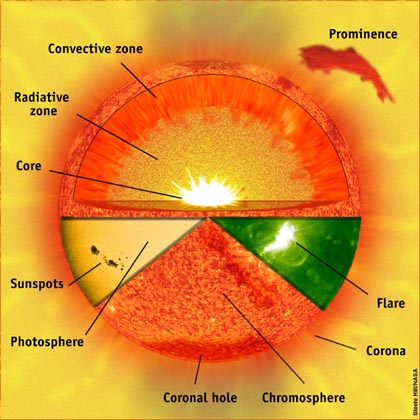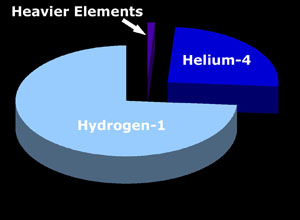Elemental Abundances
Understanding Our History
An accretion disk forms during the birth of a star.
There are precise physical and chemical processes that govern the evolution of planets, stars, and galaxies. By analyzing the structure and chemical content of astronomical objects, scientists can garner valuable information about what the universe's conditions must have been like long ago in order to account for currently observed elemental ratios.
A forming galaxy.
The Composition of the Earth
We can begin in our own backyard. Geologists have determined that the Earth is composed primarily of heavy elements (those containing many protons and neutrons). The crust and mantle are made up of compounds containing large traces of oxygen, nickel, aluminum, magnesium, iron, silicon, and sulfur. Beneath these layers lies a molten iron core. The atmosphere is made of heavier gases, principally nitrogen and oxygen.
 [2.6a] Down the Rabbit Hole: The Periodic Table
[2.6a] Down the Rabbit Hole: The Periodic Table
The Composition of the Sun

Scientists use spectroscopy to determine the composition of the Sun.
Unlike the Earth, the Sun is made primarily of light elements. It is a fairly typical main sequence star composed of 74% hydrogen, 25% helium. In the core, nuclear fusion converts hydrogen to helium, releasing large amounts of energy in the form of solar radiation and neutrino showers, while producing small traces of heavier elements in the process.
Using a technique called spectroscopy scientists analyze the absorption spectrum of the Sun in order to determine its chemical structure.
Hydrogen and Helium

Relative elemental abundances in the universe
Using powerful telescopes, scientists have made extensive spectroscopic surveys of distant stars and galaxies. The data indicates that hydrogen and helium make up nearly all of the nuclear matter in the universe. The most abundant element, hydrogen, accounts for 74% of the mass while helium contributes 25%. Heavier elements comprise less than 1% of the total.
The observed 3:1 ratio of hydrogen to helium along with the relative scarcity of heavier elements yield critical clues about the density, temperature, and expansion rate of the early universe. The correlations between these observations and the predictions of the Big Bang model are striking pieces of evidence in support for the theory.


